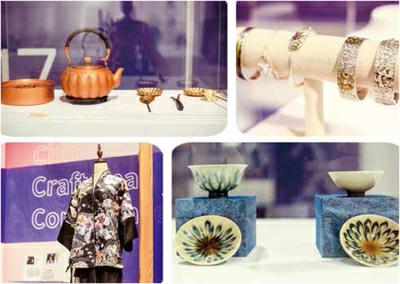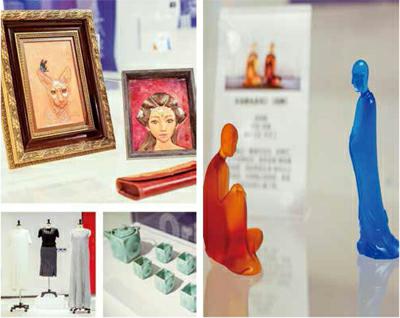匠人匠心:首届中国匠人大会
梓里
2017年7月22日,首届中国匠人大会在杭州云栖小镇举行,来自全国各地的近千名优秀匠人云集杭州,以“匠心致未来”为主题,畅谈匠人匠心。
大会发布了一份名为《中国匠人电商生态观察》的报告,说,基于匠人手作电商平台“东家”的数据分析,中国80后、90后手工艺从业者占比达到了60%。越来越多的青年群体展现出了对传统手工艺的认同,并将其作为职业选择。
传统与现代碰撞催生“新一线文化城市”
在生态观察中,杭州在国内匠人作品成交最活跃城市中排行首位。
杭州是中国历史文化名城,也是重要的风景旅游胜地。2016年G20杭州峰会的成功举办,将杭州推向了世界舞台的中心。此前多年来,杭州抢抓发展机遇,大力推动文创产业的发展。据统计,2016年杭州在这方面的产值增加达到2541亿元,占全市GDP的比重为23%。
杭州工艺与民间艺术门类众多,有丝绸、茶叶、陶瓷等20多个门类,近千个品种。2012年,杭州作为中国首个工艺与民间艺术之都,加入联合国科教文组织的全球创意城市网络,加快了工艺和民间艺术的建设。难能可贵的是,杭州一直以来十分重视传统文化的传承和保护,自2013年起,每年安排专项资金,用于带徒学艺计划,同时也十分重视传统工艺的创新和再创造,以杭州制造、中国故事等为载体,融入当代设计理念,从新的角度延伸内涵,由此涌现出了一大批具有代表意义的杭州匠人。
与杭州相同,近年来不少曾经的非一线文化城市也绽放出了惊人的活力。由于传统产区拥有丰富的原料资源和相对成熟的产业链条及人才优势,不少新锐设计师和文化创意品牌纷纷在那里集聚,像盛产瓷器的景德镇、宜兴、许昌、南平,盛产木雕的莆田等地,均入选互联网一线城市TOP20。
在这些传统产业带中,出现不少创新的电商“玩法”。东家平台推出的押窑、众筹、拍卖、直播等方式,直接带动了匠人作品销量的提升。比如,2017年,景德镇老牌瓷器“九烧”玩了一场押窑:网易同步直播八天八夜烧窑全程,累计观看人数超过300万,600件柴窑作品售罄。
年轻一代成为匠人群体新兴力量
说起手工艺匠人,我们脑海中会浮现年龄偏大、设计严谨、拥有精湛的技法和较高的业界声誉等标签。事实上,年轻一代正在逐步成为匠人群体的新兴力量。
互联网的迅速发展,催生出一批80后、90后新型电商化匠人,越来越多的青年人认同传统手工艺并将其作为新的职业选择。
在本次发布的《中国匠人电商生态观察》中,东家平台汇聚了4000余名国内外顶尖匠人和年轻匠人群体,匠人作品覆盖茶器、首饰、服装、文玩、家居、古法食品等手工艺制品。
生态观察显示,在匠人的作品中最受欢迎的是茶器。有人说,中国人的生命里应该有两滴水:一滴是墨水,一滴是茶水。品茶作为中国人的习惯,贯穿生活始终。如今,品茗、穿汉服、玩手串、抄经文……成为新一代消费者的生活方式。在不同的城市,消费者的倾向有所不同,由此呈现出有趣的地域特征。比如浙江人爱好篆刻作品、四川人喜欢乌龙茶、北京人更喜欢创意文玩,而广东人则对调味品青睐有加。
东家平台上,中国80后、90后新匠人品牌占比超过20%,而他们的从业占比则达到了60%。这些新兴群体伴随互联网成长,普遍具有国际视野,在设计思维上更加新锐、大胆,敢于创新和求变。相对于传统匠人,他们更愿意借助团队的力量完成作品的设计和制作。随着中国经济的迅速发展,空间生动化、场景生活化、美学落地化等理念,逐渐成为中国年轻一代消费者的生活追求。
传承与创新打造匠人生态圈
被称为“手工之城”的东家平台,所展示的各类物品與生活息息相关。在这里,每一件物品对应一位匠人,都有一个美好的故事;在这里,我们回归生活的本真,用独具东方美学的态度生活。
传统匠人隐世而居,为了找到他们,东家团队深入滇、黔、川、江、浙、沪、皖等地走访。从零开始,如今他们已拥有4000余名匠人。
这些精挑细选的匠人,在互联网时代找到了自己的价值。山西手工包·姥姥团队里的年轻设计师带着六旬老太太一起,回到家乡做手工包,力求打造中国的爱马仕。年轻人的现代审美与老年人的传统针线手艺相融合,奇妙的搭配,让手工包有了来自全世界的订单。东方手工制作包,走向了世界。
原属冷门的潮州手拉壶,在这里重生……
90后新兴匠人找到了展示的舞台。4000余匠人集聚于此,互动交流碰撞出新的火花,形成了匠人独有的生态圈。
那么何谓匠人?大会上,不少名家阐述了自己对匠人的理解——有情怀的守艺人。
“作为一个漫画家,我就是一个标准的中国匠人。我每天要画画16到18个小时,但我不认为自己在很努力地工作。”蔡志忠说,画画和谈恋爱、吃冰淇淋巧克力一样美好,没有所谓的努力不努力这回事。“如果品尝过这种滋味,你会觉得生命像一股甜蜜的暖流,通过我们的身躯。”
媒体人崔永元认为,“‘情怀看上去没用,但我希望这些手工作品里面带有一点情怀,带有一点我们对文化发自内心的崇拜和恭敬。有了情怀,以‘匠心致未来才有可能实现。”
中国手艺发展研究中心主任、原央视主持人赵普则对“匠人情怀”有更深刻的体会:“买卖是最好的保护、使用是最好的传承、分享是最好的传播。”“互联网+匠人”,不仅需要满足个性需求的消费潮流,更重要的是,让“守艺人”不再闭门造车,通过“买卖”与“使用”,让传统文化在传承与创新的激荡中鼓浪前行。endprint
(本文照片由“東家”提供)
Crafted by Hands, Shared through Internet
By Zi Li
The first China Craftsmen Conference, themed ‘Craftsmanship: An Ode to the Future and kicking off in Yunqi Town in Hangzhou on July 22, 2017, drew participation of about 1,000 craftsmen from all over the country. According to a report released by the conference based on the statistics on www.idongjia.cn, the 1980-90s generation accounts for more than 60% of the countrys craftsman community and traditional handicrafts are taken by more and more young people as a career choice.
Statistics also show the craftsmen in Hangzhou are taking the lead in the countrys handicraft renaissance in terms of transaction volume. The citys cultural innovation boom had emerged years before the 2016 G20 Summit that brought the city closer to the center of the global stage. The citys production value of handicraft industry topped 254 billion yuan in 2016, taking up 23% of the city GDP.
Boasting a unique diversity of folk arts and crafts stretching across more than 20 categories represented by silk, tea and ceramics, Hangzhou joined the UNESCO Creative Cities Network (UCCN), a project of UNESCO launched in 2004 to promote cooperation among cities which recognize creativity as a major factor in their urban development, in 2012. The city has been sparing no effort in the conservation and reinvigoration of traditional culture and arts, as shown in a series of themed projects encouraging cultural innovation, such as ‘Made in Hangzhou and ‘China Story.
Many other cities with profound cultural tradition of distinct regional features, such as Jingdezhen, Yixing, Xuchang, Nanping and Putian, are also displaying striking potentials in cultural innovation. The magic power of e-commerce platforms innovated by www. idongjia.cn have brought the reputation of ‘Jiushao, a time-honored porcelain brand hailing from Jingdezhen, to a new high. The entire firing process that took eight days and nights, broadcast live on NetEase, was viewed by more than three million people. The 600 wood-fired products from the kiln sold out within a few hours.
Great changes are taking place in the handicraft genome of China, with traditional handicrafts being taken by more and more young people as a career choice. According to the report released by the Hangzhou conference, www.idongjia.cn has created an online platform where more than 4,000 top-notch craftsmen all over the globe gather together to share the immense beauty of a wide range of traditional crafts from teaware and jewelry to furniture and food processing by ancient methods.endprint
Teaware stands out as the most popular. Tea-related culture is becoming an integral part of the everyday life of a fast-growing number of quality-sensitive people all over China. For example, people in Sichuan Province have a special weakness for oolong tea.
Brands run by the 1980-90s generation accounts for more than 20% of the ‘craftsmen club on idongjia.cn. Born into the world of Internet, the countrys younger generations are not only more open-minded and creative than the elder generations of craftsmen, but also more willing to rely on team work to achieve the desired quality and aesthetic conception.
Dubbed “the platform of handicrafts”, idongjia.cn is a showroom of everything about the art of life, telling the story behind each product and bringing us back to the ‘basics and ‘truth.
Working behind closed doors is becoming history. How craftsmen work and live is becoming increasingly seeable on the internet. Through the online platform, the virtuoso needlework of a Shanxi-based woman in her 60s is given a new life and drawing orders from all over the world.
“I am a Chinese craftsman in the true sense of the word. I spend 16-18 hours drawing every day, but I enjoy every minute of the process. It is not ‘hard work, but feels just like falling in love,” said Taiwanese caricaturist Tsai Chih Chung.
“Putting the crafts on the track of transaction is the best way of conservation; putting the artwork into use in everyday life is the best way of inheritance; and sharing is the best way of communication,” concluded Zhao Pu, Director of China Handicrafts Development and Research Center and former CCTV news host.endprint

